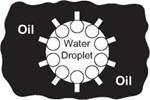 Water in oil emulsions
Water in oil emulsions
|
|
The water in invert emulsion muds is dispersed as small droplets throughout the oil. Emulsifiers coat the droplets, preventing them from coalescing and making the mud unstable (i. e. larger water droplets will settle out and break down the emulsion). A calcium or magnesium fatty acid soap is often used as an emulsifier in an oil- based mud. The long hydrocarbon chain of the soap molecule tends to be soluble in oil while the ionic portion tends to be soluble in water. When soap is added to a mixture of oil and water the molecule takes up the position shown in Figure 15.
|
|
•••••••• ••••••••
Figure 15 Water droplets dispered in a continuous oil phase.
|
% |
This reduces the surface energy of the interface and keeps the water droplets in the emulsion. Other types of emulsifiers can also be used (e. g. naphthenic acid soaps and soaps from tree sap). The effectiveness of an emulsifier depends on the alkalinity and electrolytes present in the water phase and also on the temperature of the mud. To increase the stability the water droplets should be as small and uniform as possible. This is done by shearing the mud by agitators. When oil is added the stability increases, since the distance between droplets becomes greater. This causes a decrease in viscosity. For good mud properties there must be a balance between oil and water. The water droplets help to:
• Support the barite
• Reduce filter loss
• Build viscosity and gel strength
When a drop of liquid is placed on a solid it will either:
• Spread itself over the surface of the solidor
• Remain as a stable drop
The shape that the drop takes up depends on the adhesive forces between the molecules of the solid and liquid phases. The wettability of a given solid surface to a given liquid is defined in terms of the contact angle q (Figure 16). For a solid/ liquid interface which exhibits a small contact angle (<90 degrees), the solid is preferentially wetted by the liquid. Thus in Figure the solid is preferentially water wet. If q = 0 degrees, then the solid is totally water wet. When two liquids are present and brought into contact with a solid, one of the liquids will preferentially wet the solid. Most natural minerals are water wet. When water wet solids enter an emulsion the solids tend to agglomerate with the water, and settle out. To overcome this problem surfactants are added to the oil phase to change the solids from being water wet to being oil wet. The soaps added as emulsifiers will also act as wettability control agents, but special surfactants are more effective. The stability of the emulsion can be tested by measuring the conductivity of the mud. The stronger the emulsion the higher the voltage required for an electric current to flow. A loose emulsion is often due to water wet solids or free water. When water-wet solids are present the surface of the mud becomes less shiny and the cuttings tend to stick to each other and blind the shale shaker. Barite added for density control must also be oil wet otherwise the particles will tend to settle out.
